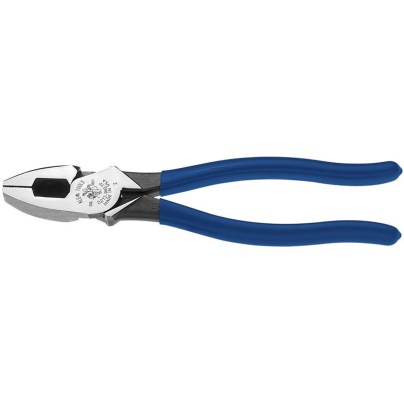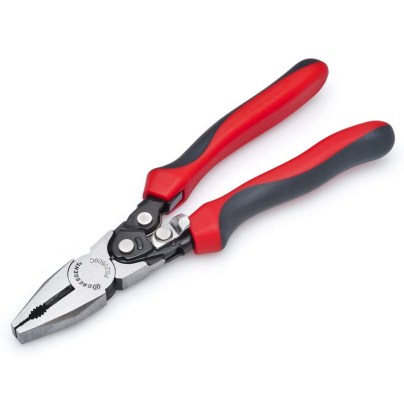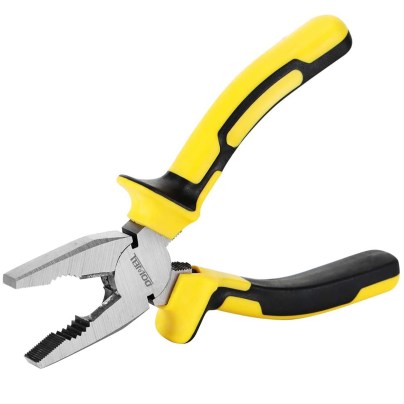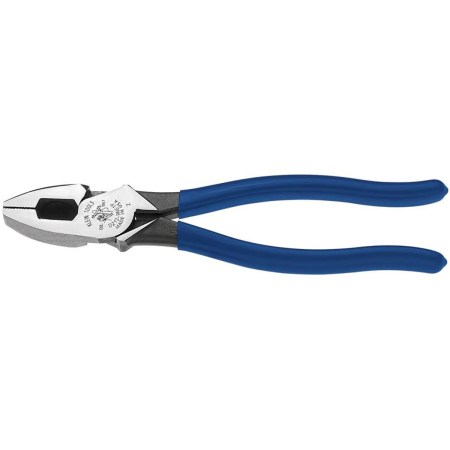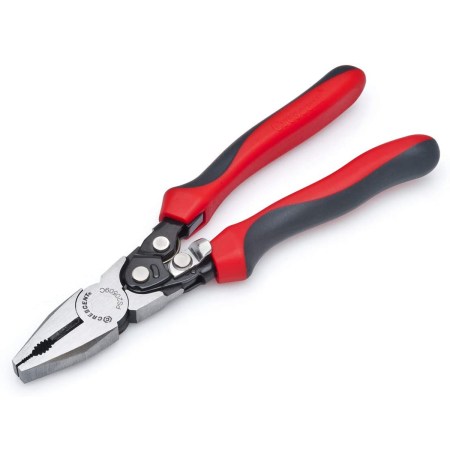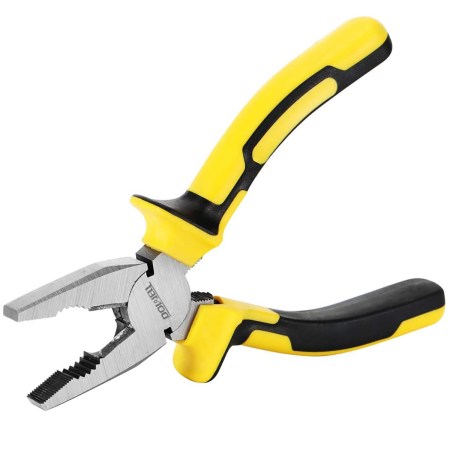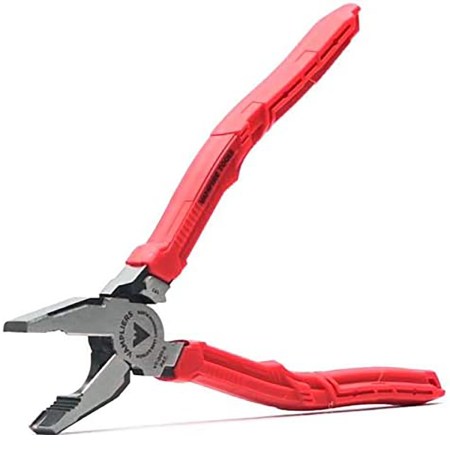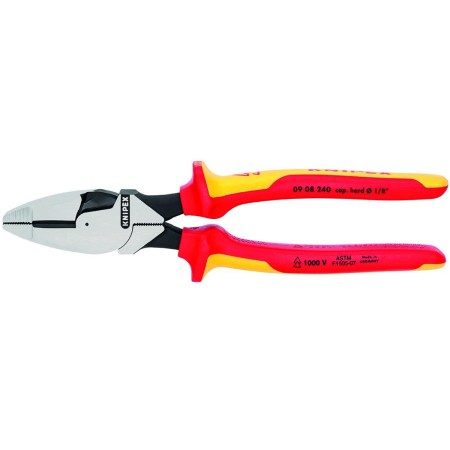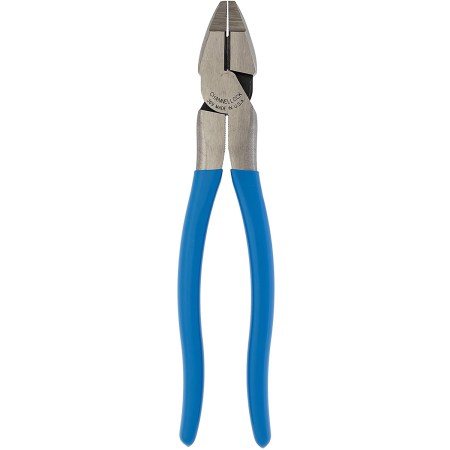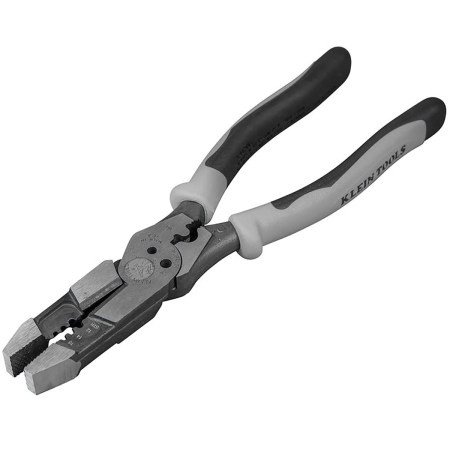We may earn revenue from the products available on this page and participate in affiliate programs. Learn More ›
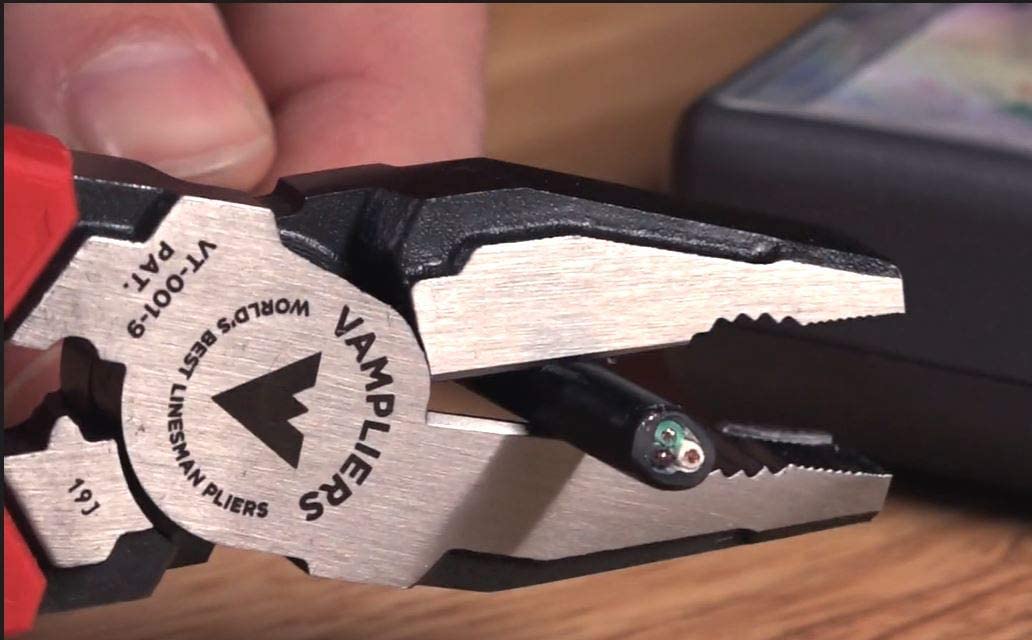
Every home electrician’s tool belt should carry at least one pair of lineman pliers. Used by people in the electrical trade, these tools can cut, straighten, and bend wire as well as twist wires together when making splices. Whereas professionals often buy separate tools for wire cutting and stripping, the best lineman pliers can tackle both tasks and thus save money, particularly for occasional DIY users.
In addition to gripping, twisting, bending, and cutting wires and cables, the best lineman pliers can also pull out nails, straighten or bend metal brackets, undo stubborn bolts, grip pipework, and more. These versatile tools aren’t just essential for electrical work; they are also handy for dozens of tasks around the home, garage, and yard.
- BEST OVERALL: Klein Tools D213-9NETP Lineman’s Pulling Pliers
- RUNNER-UP: Crescent 8″ Pro Series Dual Material Lineman’s Pliers
- BEST BANG FOR THE BUCK: DOWELL Lineman’s Pliers Combination Pliers
- UPGRADE PICK: VAMPLIERS. Screw Extractor Pliers
- BEST INSULATED: Knipex 09 08 240 SBA 9.5-Inch Lineman’s Pliers
- BEST LEVERAGE: Channellock 369 9.5-Inch Lineman’s Pliers
- ALSO CONSIDER: Klein Tools J215-8CR Multitool Pliers
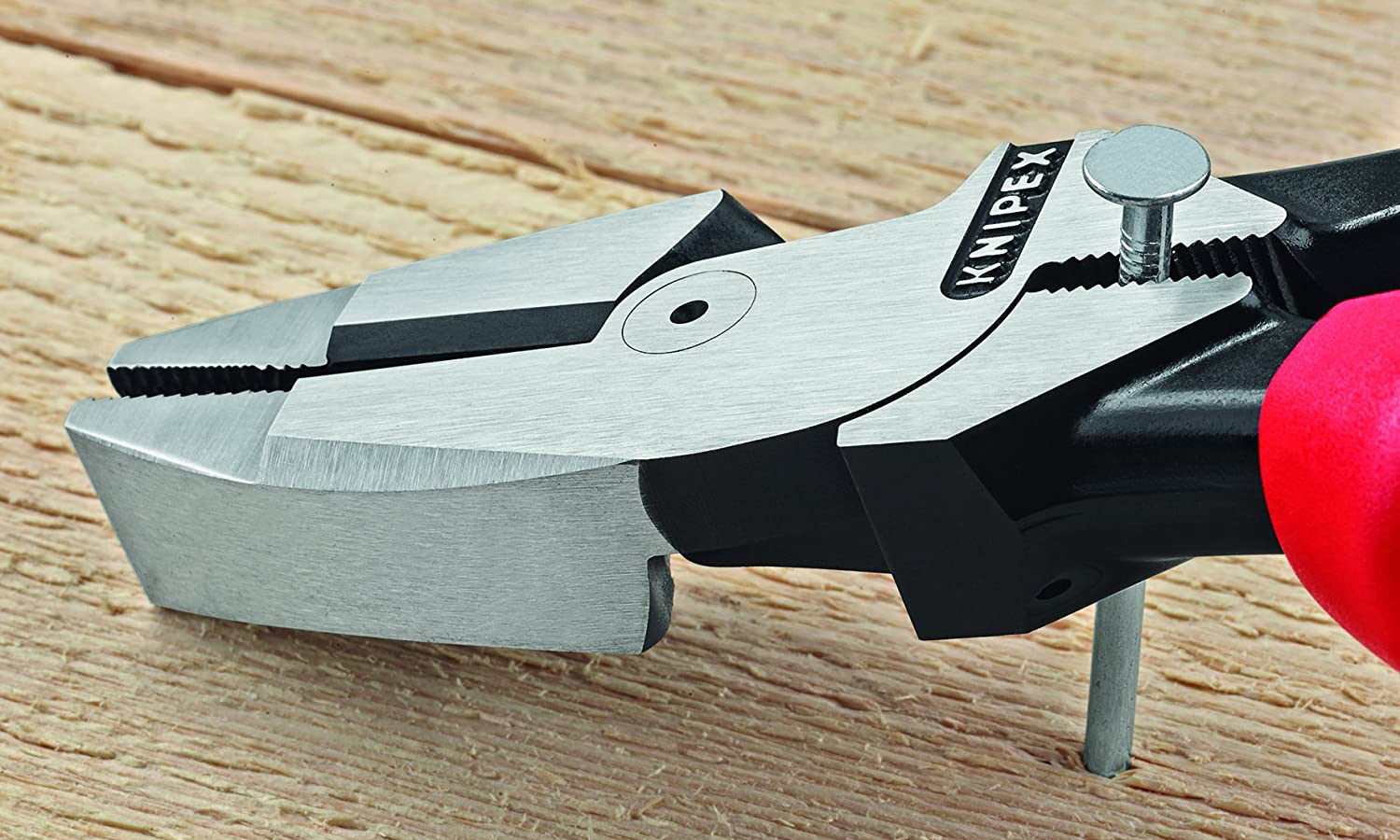
What to Consider When Choosing the Best Lineman Pliers
The best lineman pliers have features that can handle electrical work while also lending themselves well to general purpose use. Different models offer a range of functions that suit particular tasks. That said, there is considerable variety in the market, with pliers of all different sizes, construction, and material. Depending on what the tool will be used for, keep the following considerations in mind while shopping.
Intended Use
The main purpose of lineman pliers is in the name: Linemen and women, whether dealing with electrical or other cable installations, work with wires and cables all day. These professionals need a robust tool that can strip back insulation and cut, bend, twist, or splice the bare ends.
However, lineman pliers also offer tremendous versatility. The jaws can be useful for grasping all kinds of objects and materials, either for a firm hold or perhaps when undoing stubborn fixings. Some can provide impressive leverage to remove nails or even cut through them. Particular models have a channel for securing a fish tape (a device for feeding wiring through conduit), while others can be used to crimp certain types of electrical connector.
Material
All lineman pliers are made from steel alloy, which is iron with carbon added. It’s a very strong material used in all kinds of different tools. However, different steel alloy compounds offer different levels of durability and rust resistance.
Many lineman pliers are made with high-carbon steel, which is very durable, though prone to rust without a protective coating. Better-quality lineman pliers use nickel chrome steel or chrome vanadium steel. These materials have similar toughness to high-carbon steel, but the addition of chrome makes them resistant to rust and often lends tools a bright finish. They also have increased ductility, meaning they can deform or bend slightly without failing, which is useful for the pliers’ handles. A few models use stainless steel, which also combines high-carbon steel, chromium, and nickel. The resulting alloy is very strong, highly resistant to wear, and does not rust. It is an excellent choice, but it tends to be pricey.
Gripping Jaws
The gripping jaws on lineman pliers almost always have a flat, ridged area at the ends (nose). When combined with the leverage provided by the handles, great force can be exerted. On some of the more versatile types of lineman pliers, these flats may be sculpted to allow the nose to be used for extracting screws or other round fasteners.
Closer to the hinge there is often—though by no means always—a curved area designed for gripping round objects. The serrations around the inside edge of this section also allow for clamping on to nuts and bolts. Using a wrench or a socket is always the best approach, because lineman pliers can damage the fixing, but in a pinch, the pliers are often a quick and convenient solution.
Quite often there is an additional gripping area behind the hinge, at the top of the handles. Alternatively, some lineman pliers are specifically designed to crimp electrical connectors and terminals.
Cutting Edges
Another term for lineman pliers is side-cutters. The main cutting edges are just in front of the hinge. On better tools these have been induction hardened using an electrical current so that they stay sharp longer. With gentle pressure, it’s easy to strip the plastic insulation from wire or cable. With more pressure, it’s possible to cut right through the wire or cable underneath. Depending on the length and design of the handles, it’s also possible to cut through nails, screws, or small bolts.
The sides of the hinge often form a channel for grasping fish tape, but sometimes they have small U-shaped slots. Tools with this feature can be used as heavy-duty wire cutters.
Size, Weight, and Maneuverability
Lineman pliers typically range in length from 6 inches to 10.5 inches. Smaller pliers are easier to handle and a better option for those who need to work in confined spaces, while larger pairs can exert substantial amounts of force for heavy-duty wire cutting, metal bending, and so on. Some manufacturers produce the same pliers in a range of sizes, offering excellent versatility for those who find a model they particularly like.
None of these tools is especially heavy, generally ranging from around ½ pound to slightly over 1 pound. However, the weight can have a bearing if the tools are used all day, particularly if a lot of wrist movement is involved. Ultimately, performance and durability should be the primary concerns. If those can be achieved and weight can be saved, then so much the better.
Comfort
How comfortable a pair of lineman pliers is largely depends on the handle design and materials used to cover them. Some simpler models may just have the handles dipped in molten polyethylene. On quality tools, this provides a tough nonslip skin between the metal handles and the user’s hands. However, it’s worth checking carefully when found on low-cost lineman pliers, as the coating can be very thin and may not last long.
Other models may have thicker material and improved ergonomic shape, featuring a hard plastic coating for durability with rubberized inserts for increased hand comfort.
Hand size might also be a factor that dictates comfort. Using too-large lineman pliers might mean frequently overstretching one’s fingers, which can be uncomfortable and unwieldy. Good handle design will often limit this, but those with smaller hands will want to be careful with their choice.
Our Top Picks
Now that you understand the primary features and how they will impact your choice, it’s time to focus on superior lineman pliers across a variety of different categories. This will allow you to quickly find the right model for your needs.
Best Overall
Klein Tools D213-9NETP Lineman's Pulling Pliers
See ItAimed at professionals but user-friendly enough for anyone’s tool box, Klein Tools’ 9-inch lineman pliers are made from tough forged steel with crosshatched jaws for secure grip and induction-hardened cutters for improved edge retention. There are channels which close securely on both ⅛-inch or ¼-inch fish tapes, allowing for strong pulling without causing damage, something that can be a problem with low-cost models.
Thick polypropylene-coated handles are designed to maximize comfort and user input and can apply extra power for gripping or cutting. They have also been tempered (heated then cooled rapidly) so that they absorb the impact of cutting through hard wires. At just over 1 pound, these lineman pliers are a bit on the heavier end of the scale, but they’re not heavy enough to be unwieldy. For those who demand exceptional quality and precision, these lineman pliers are worth the investment.
Runner-Up
Crescent 8u0022 Pro Series Dual Material Lineman's Pliers
See ItThese 8-inch lineman pliers from Crescent are made from chrome vanadium steel, one of the optimal materials for these tools thanks to its toughness, ductility, and rust resistance. Using a clever compound lever mechanism, these handy pliers deliver up to 50 percent more cutting or gripping pressure for the same physical input as standard pliers. Their lifespan is further improved thanks to their induction-hardened cutting edges, and a heat-treated joint rivet ensures smooth, consistent operation.
Co-molded handles combine durability and comfort, and a useful locking tab keeps them compact while not in use. At just 4.3 ounces they are remarkably light for their size, making them a great choice for someone who will be using them for long periods at a time.
Best Bang For the Buck
DOWELL Lineman's Pliers Combination Pliers
See ItIt’s natural to have concerns about performance and durability when considering low-cost tools. Dowell’s 6-inch lineman pliers may be aimed at those on a limited budget, but the use of tough, rust-resistant nickel chrome steel should allay many fears. These affordable lineman pliers boast induction-hardened cutting edges, a hallmark of high-quality tools, as well as ergonomically designed handles that make for easy grip and good comfort. Furthermore, these pliers also comply with American National Standards Institute (ANSI) production requirements.
At 6 inches long, these half-pound lineman pliers are ideal for light DIY use. For those who need something with a bit more muscle, Dowell also makes 7-inch and 8-inch models to the same standard, both of which offer equally good value.
Upgrade Pick
VAMPLIERS. Screw Extractor Pliers
See ItVampliers tools have several impressive features. They are made from high-carbon stainless steel, which is rarely found in pliers because it’s expensive; however, it is both extremely durable and does not rust. The handles are wrapped in elastomer, a hard-wearing plastic with the comfortable feel of rubber.
The cable cutter and fish tape puller are important inclusions, but it’s the gripping jaws of these 9-inch pliers that stand out. Featuring both horizontal and vertical serrations, they’re capable of grasping small nuts and bolts and awkward fixings like Torx screws from the top rather than the side. This can be a big advantage when space is limited, especially if components are corroded or damaged, or if the proper unfastening tool is not readily available. Weighing 14.4 ounces, these sturdy pliers won’t feel overly heavy in hand.
Best Insulated
Knipex 09 08 240 SBA 9.5-Inch Lineman’s Pliers
See ItKnipex is widely recognized for the high quality of their tools, and these 9.5-inch chrome vanadium lineman pliers are a fine example. The jaws are crosshatched for a secure hold, and their cutting edges are induction hardened to stay sharp for longer.
An interesting design feature is that the rivet has been moved forward from the usual central position, increasing leverage for gripping and cutting, while an additional gripping area behind the hinge allows for extra force to be applied for things like nail extraction.
The dual-component handles offer excellent comfort, but more importantly they provide insulation to 1,000 volts, as defined by the independent IEC (International Electrotechnical Commission) and ASTM International standards. The tool is clearly marked with the latter specification, an important feature to check when buying insulated lineman pliers. Weighing in at just over 1 pound, these pliers offer a bit of heft in hand.
Best Leverage
Channellock 369 9.5-Inch Lineman's Pliers
See ItThere are a lot of things to like about these 9.5-inch lineman pliers from Channellock. Made of tough high-carbon steel, they have been hardened using a laser heat treatment, which focuses on specific areas (like the gripping jaws and cutting edges) without affecting the ductility of the surrounding areas. The cutting edges feature an unusual knife and anvil style, which offers superior performance.
But the stand-out feature of this tool is the Xtreme Leverage Technology (XLT), which maximizes user input. When compared to standard lineman pliers, they allow the application of more pressure when gripping, twisting, or cutting without overexerting oneself. It’s a particularly valuable feature for those who regularly cut hard materials like piano wire, and it’s also helpful when considering their slightly higher weight, clocking in at 1.08 pounds.
In addition to the 9.5-inch size, these lineman pliers come in sizes from 7.5 inches to 10.5 inches.
Also Consider
Klein Tools J215-8CR Multitool Pliers
See ItKlein Tools’ 8-inch multipurpose lineman pliers offer all the standard gripping and cutting features expected, plus several useful extras.
With care, any lineman pliers can be used to strip insulation, but there’s always a danger of cutting through the wire or cable beneath. This tool provides a wire-stripper insert that effectively avoids this problem. The hinge section incorporates a powerful cutter for common 6-32 and 8-32 bolts, and there’s also a crimper for popular non-insulated terminals and connectors.
Overall construction is to Klein Tools’ usual standard. The high-leverage design transmits power effectively. The cutting edges are induction hardened, and the handles are made from comfortable dual-material compounds.
FAQs About Lineman Pliers
The information provided so far should give a comprehensive understanding of the capabilities of the best lineman pliers, and you’ve had the opportunity to take a closer look at some prime examples. There may still be a few lingering questions that remain unanswered, so here are some answers to the most common ones.
Q. What are lineman pliers used for?
Lineman pliers are designed for gripping, stripping, cutting, and twisting of wire and cable, but they are versatile tools and make a great addition to any tool kit.
Q. Are lineman pliers insulated?
Some are, but many are not. It’s certainly not something you should take for granted. Also check the level of insulation, which does vary. Insulated lineman pliers should bear markings detailing their capabilities.
Q. How do I maintain my lineman pliers?
Wipe down lineman pliers after use and lubricate them occasionally with light machine oil. Do not use silicone sprays, which can actually attract dust and grit. If they do start to rust, use a small wire brush to remove it.
Q. How long do lineman pliers usually last?
If properly looked after, the best lineman pliers will last many years. You may only ever buy one pair, especially if they don’t see heavy use.
